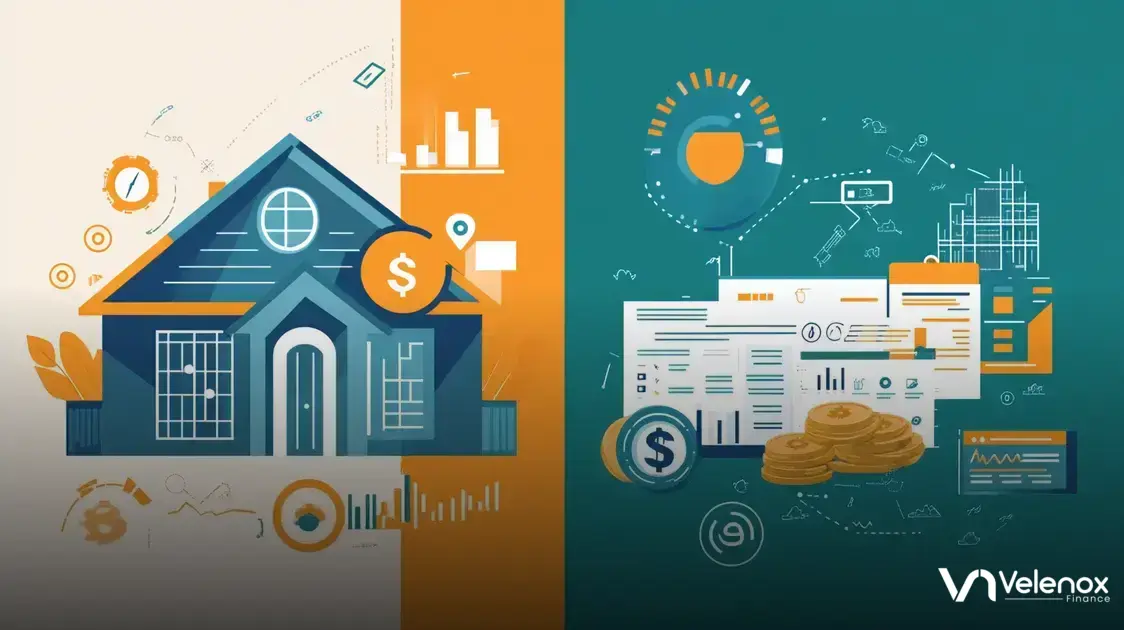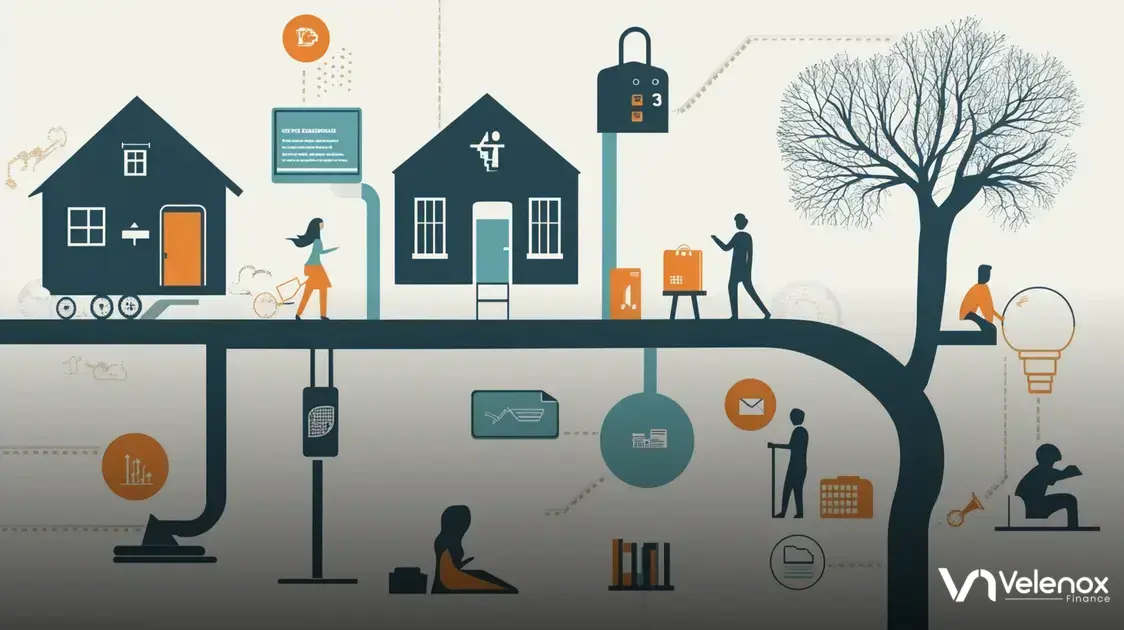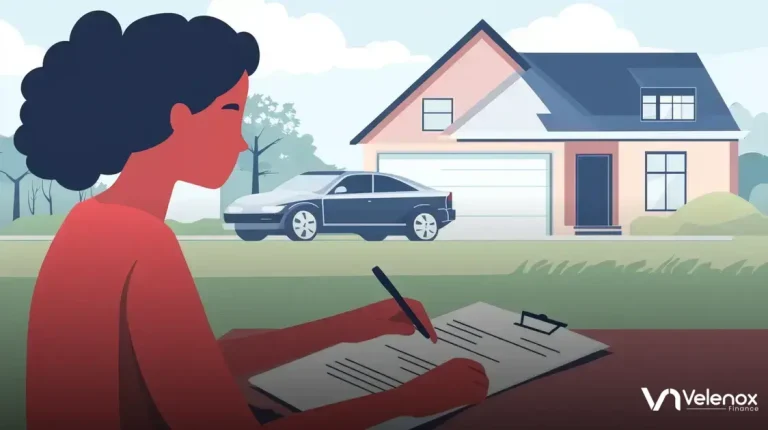Secured loans use collateral to help borrowers access funds at lower interest rates and with favorable terms.
They can be an excellent tool for achieving financial goals, but it’s essential to understand the associated risks and common misconceptions before applying.
Secured loans offer a unique financial solution for those in need of funds.
By using an asset as collateral, borrowers can access larger loan amounts at lower interest rates.
This makes secured loans an attractive option for many looking to finance various needs, from home improvements to personal expenses.
What are Secured Loans?
Secured loans are a type of borrowing in which the borrower pledges an asset, such as a home or a vehicle, as collateral to obtain funds.
This means if you cannot repay the loan, the lender can take possession of the asset to recover their money.
Because this type of loan is backed by collateral, lenders generally offer lower interest rates compared to unsecured loans.
How Secured Loans Work
When you apply for a secured loan, you will need to provide information about the asset you wish to use as collateral.
The lender will assess the value of this asset before approving the loan amount.
The amount you can borrow will depend on the value of your collateral, your credit history, and your ability to repay the loan.
Once approved, you will receive the loan amount in a lump sum. Monthly payments will be required over a specified term until the loan is paid off.
During this time, the lender retains the right to the collateral until the loan is fully repaid.
Additional Considerations
Secured loans can be an excellent option for large purchases or consolidating debt. However, it’s crucial to understand the risks involved.
If you default on your payments, you risk losing the collateral you put up.
It’s essential to ensure that you can manage the monthly payments comfortably before taking on a secured loan.
How Secured Loans Work
Secured loans operate on a straightforward principle: they require collateral to back the borrowed amount.
This collateral can be anything from a car to a home, typically a valuable asset that the lender can reclaim if you fail to repay the loan.
Understanding how secured loans work is essential before applying for one.
Application Process
To obtain a secured loan, you need to start with an application.
During this process, you will provide details about the collateral, your financial situation, and the desired loan amount.
Lenders will assess your credit history as well to make a decision.
Valuation of Collateral
Once you apply, the lender will conduct a valuation of the collateral asset. This assessment will determine how much the lender is willing to offer you.
Typically, they will lend a percentage of the asset’s value, meaning you might not receive the full market price.
Loan Terms
Loan terms for secured loans vary, but you can generally expect longer repayment periods compared to unsecured loans.
Terms can range from a few months to several years. Lower interest rates are also common since the loan is secured against an asset.
Monthly Payments
After approval, you’ll start making monthly payments. These payments will include both the principal amount and the interest that accrues over time.
It’s essential to stay on top of these payments to avoid losing your collateral.
Default Consequences
If you fail to make payments on your secured loan, the lender has the right to seize the collateral. This process is known as repossession.
It’s crucial to only borrow what you can afford to repay to prevent losing your asset.
Benefits of Secured Loans

Secured loans come with several advantages that make them a practical choice for many borrowers.
Understanding these benefits can help you decide if a secured loan fits your needs.
Lower Interest Rates
One significant benefit of secured loans is the lower interest rates compared to unsecured loans.
Because the lender has collateral to protect their investment, they often pass on these savings to you in the form of lower interest.
Higher Loan Amounts
Secured loans generally allow you to borrow a larger amount of money. Since your asset acts as collateral, lenders are more willing to provide a substantial loan.
This can be useful for major expenses like home renovations or debt consolidation.
Improved Approval Chances
With a secured loan, your chances of approval are typically higher, particularly if you have a limited credit history or a lower credit score.
Lenders feel more secure knowing they have collateral backing the loan.
Flexible Repayment Terms
Secured loans often offer flexible repayment terms.
You might have the option to choose the length of your loan repayment period, giving you the ability to customize your payments according to your budget.
Potential for Building Credit
Making timely payments on a secured loan can help improve your credit score. This is especially beneficial if you are trying to build or rebuild your credit history.
Lenders report your payments to credit bureaus, allowing you to show responsible borrowing behavior.
Types of Secured Loans
There are several types of secured loans, each serving different financial needs.
Understanding these types can help you choose the right loan for your situation.
1. Home Equity Loans
A home equity loan allows you to borrow against the equity you have built up in your home.
This type of loan is often used for home improvements or major expenses. You receive a lump sum amount that you repay over a fixed term.
2. Home Equity Line of Credit (HELOC)
A HELOC is similar to a home equity loan but works more like a credit card.
You are given a credit limit based on your home equity, and you can withdraw funds as needed during a specified draw period. Repayment terms may vary.
3. Auto Loans
Auto loans are secured by the vehicle you are purchasing. Lenders use the car as collateral, meaning if you default on the loan, they can repossess the vehicle.
These loans usually have a set term and fixed interest rates.
4. Secured Personal Loans
Secured personal loans allow you to borrow money against an asset like savings accounts or CDs.
They are generally easier to qualify for and can provide higher borrowing limits than unsecured options.
5. Boat or RV Loans
Similar to auto loans, boat or RV loans are used to purchase recreational vehicles and are secured by the vehicle itself.
They often come with specific loan terms tailored for leisure vehicles.
6. Certificate of Deposit (CD) Loans
CD loans are secured against a certificate of deposit.
You can borrow a percentage of the amount in the CD, and while you have the loan, your CD remains locked. This type of loan usually features low interest rates.
How to Apply for a Secured Loan
Applying for a secured loan can seem daunting, but the process is straightforward. Follow these simple steps to improve your chances of approval.
1. Assess Your Financial Needs
Begin by determining how much money you need and what you plan to use it for.
Knowing your specific needs will help you choose the right loan type and amount.
2. Check Your Credit Score
Your credit score plays a significant role in the approval process. Check your score before applying for a secured loan.
A higher score can improve your chances and may lead to better interest rates.
3. Choose Your Collateral
Identify the asset you wish to use as collateral for the loan. This could be your home, car, or savings account.
Ensure the collateral is valuable and can cover the loan amount.
4. Research Lenders
Different lenders offer various terms and interest rates.
Take the time to research and compare different institutions, including banks, credit unions, and online lenders.
Look for lenders with favorable reviews and competitive rates.
5. Prepare Documentation
You will need to provide documentation during the application process.
Common documents include proof of income, information about the collateral, and your personal identification.
Gather these documents to streamline your application.
6. Fill Out the Application
Once you have chosen a lender, complete the loan application. Be honest and accurate when filling out the application to avoid any issues later on.
7. Wait for Approval
After submitting your application, the lender will review it. They may contact you for additional information or further documentation.
The approval process can take from a few hours to several days.
8. Review Loan Terms
If approved, carefully review the loan terms, including interest rates, repayment timeline, and any fees.
Make sure you understand your obligations before accepting the loan.
9. Accept the Loan
After reviewing everything, you can accept the loan offer. It’s essential to keep a copy of all documentation and agreements for your records.
Secured Loans vs. Unsecured Loans

When considering loans, it’s vital to understand the key differences between secured loans and unsecured loans.
Each type has its own set of advantages and disadvantages that influence your borrowing decision.
Definition
A secured loan requires collateral, meaning you must pledge an asset, like a house or car, to secure the loan.
If you fail to repay, the lender can take the asset. In contrast, an unsecured loan does not require collateral.
Instead, lenders assess your creditworthiness and income to determine approval.
Interest Rates
Secured loans generally come with lower interest rates compared to unsecured loans.
This is because lenders perceive secured loans as less risky, given the collateral provided.
Unsecured loans often attract higher interest rates due to the increased risk for lenders.
Loan Amounts
Since secured loans are backed by an asset, borrowers can often access larger loan amounts.
Unsecured loans typically have lower limits because they do not have collateral backing.
This can limit the amount you can borrow based on your creditworthiness.
Approval Process
The approval process for secured loans can be quicker, as the presence of collateral reduces the lender’s risk.
Unsecured loans may take longer, especially if the lender has to verify your income and credit score thoroughly.
Risks
One significant risk of secured loans is the potential loss of your asset if you cannot repay.
With unsecured loans, the risks mainly involve damaging your credit score and facing higher interest rates, but you won’t lose an asset directly.
Use of Funds
Secured loans are often used for significant expenses, such as home renovations or consolidating debt, while unsecured loans may be used for smaller purchases or emergencies.
Depending on your need, one type may be more suitable than the other.
Which is Right for You?
Your choice between secured and unsecured loans will depend on your financial situation, credit history, and comfort with risk.
If you have valuable collateral and need a larger loan, a secured loan might be best. If you prefer not to risk an asset, an unsecured loan could be the way to go.
Risks Involved with Secured Loans
While secured loans can provide valuable financial opportunities, there are several risks involved that borrowers should consider carefully.
1. Risk of Losing Collateral
The most significant risk of a secured loan is the potential loss of your collateral.
If you fail to repay the loan, the lender has the right to seize the asset you used as collateral. This could mean losing your home, car, or other valuable property.
2. Difficulty in Managing Payments
Secured loans often have larger amounts and longer repayment terms.
If your financial situation changes unexpectedly, such as losing your job, you might struggle to keep up with payments.
This could lead to default and loss of the collateral.
3. Lower Credit Scores
If you default on a secured loan, it can significantly affect your credit score.
A lower credit score can make it harder to secure loans in the future or lead to higher interest rates when you do.
4. Limited Borrowing Options
Borrowing against an asset can limit your options with future loans.
Lenders may hesitate to approve additional loans if you already have a secured loan, as they may view you as a higher risk.
5. Fees and Costs
Secured loans may come with various fees that add to the overall cost of borrowing.
These can include appraisal fees for the collateral, closing costs, and other administrative fees.
It’s essential to understand these costs before committing to a loan.
6. Emotional Stress
The pressure of borrowing against an asset can lead to emotional stress.
Worrying about meeting monthly payments or losing your collateral can take a toll on your mental health.
It’s important to borrow responsibly and only take on what you can manage.
Tips for Choosing a Secured Loan
Choosing the right secured loan can make a significant difference to your financial well-being.
Here are some helpful tips to guide you through the decision-making process.
1. Determine Your Needs
Before applying for a secured loan, clearly define your financial needs.
Consider how much money you need and what you will use it for, whether it’s for home improvement, debt consolidation, or other expenses.
2. Evaluate Your Collateral
Identify the asset you plan to use as collateral.
Ensure it has enough value to cover the loan amount and is something you are comfortable risking in case of default.
3. Compare Interest Rates
Shop around to find the best interest rates.
Different lenders offer various rates based on their assessment of risk and collateral, so comparing options can save you money over time.
4. Review Loan Terms
Carefully read the loan terms and conditions. Look for details regarding the repayment schedule, fees, and penalties for late payments.
Understanding these factors will help you avoid surprises later on.
5. Check Lender Reputation
Research potential lenders to ensure they have a solid reputation.
Read customer reviews and check their ratings with organizations like the Better Business Bureau to find trustworthy institutions.
6. Assess Your Budget
Before taking on a secured loan, evaluate your budget.
Make sure you can afford the monthly payments given your current financial situation to avoid risking your collateral.
7. Understand the Risks
Be aware of the risks associated with secured loans.
If you default, you could lose your collateral, which could be a significant asset such as your home or vehicle.
8. Seek Professional Advice
If you’re unsure about your decision, consider consulting a financial advisor or loan expert.
They can provide personalized advice and help you make informed choices about secured loans.
Common Misconceptions about Secured Loans

There are many common misconceptions about secured loans that can lead to confusion for borrowers. Here are some of the most prevalent myths clarified.
1. You Need Perfect Credit
Many people believe that only those with perfect credit can qualify for a secured loan.
While a good credit score can help, lenders typically consider the collateral more than your credit history.
This means individuals with lower credit scores can still qualify.
2. Secured Loans Are Always Risky
Some may think that all secured loans are inherently risky due to the potential loss of collateral.
While there are risks, if managed properly, secured loans can be a safe and sensible way to borrow money, especially with low interest rates.
3. You Can’t Borrow a Large Amount
Another misconception is that secured loans don’t allow for large borrowing amounts.
In reality, secured loans often enable borrowers to access larger sums because they are backed by valuable assets, giving lenders more confidence.
4. All Secured Loans Have High Fees
Many assume that secured loans come with high fees. While some lenders do charge fees, not all do.
It is crucial to compare lenders to find those that offer secure loans with low or no fees.
5. You Can Use Any Asset as Collateral
Some people think they can use any asset to secure a loan. However, not all assets are acceptable as collateral.
Lenders typically require specific types of assets, such as real estate or vehicles, that have clear titles and value.
6. Secured Loans Are Just for Bad Credit Borrowers
A misconception is that secured loans are only for those with bad credit.
In reality, even borrowers with good credit can choose secured loans to take advantage of lower interest rates and larger loan amounts.
7. You Will Definitely Lose Your Collateral
Many fear losing their collateral if they take a secured loan.
While this is a risk, as long as you make your payments on time, you can retain ownership of your asset.
Responsible borrowing and budgeting are key to avoiding this outcome.
The Path to Financial Freedom with Secured Loans
Secured loans can be a powerful tool for achieving financial goals.
By using collateral, borrowers can access funds at lower interest rates and often with more favorable terms.
Throughout this guide, we’ve explored what secured loans are, how they work, their benefits, types available, and critical factors to consider when applying.
Additionally, it’s essential to understand the risks and the common misconceptions surrounding secured loans to make informed decisions.
When approached thoughtfully, secured loans can lead to significant financial benefits without unnecessary risk.
For anyone considering borrowing, we encourage careful evaluation of your needs, thorough research on lenders, and honest assessments of your financial situation.
With the right preparation, secured loans can help unlock the door to your dreams and aspirations.





